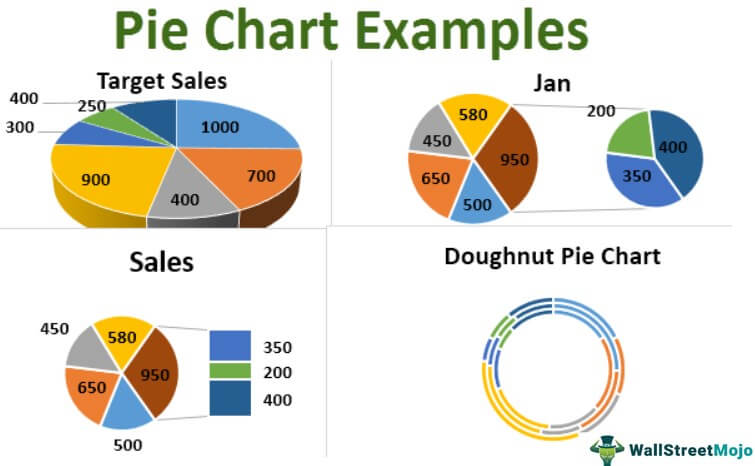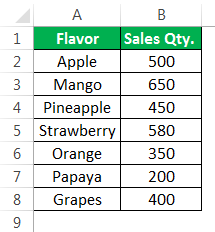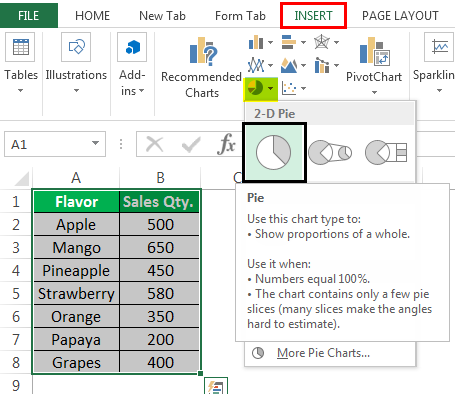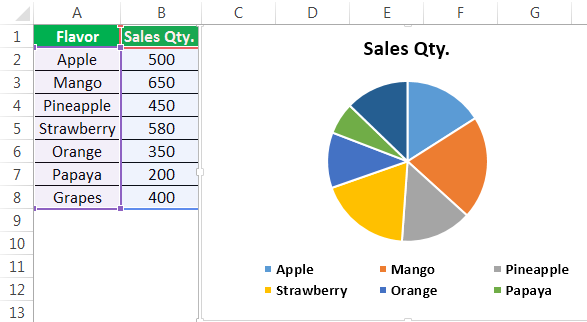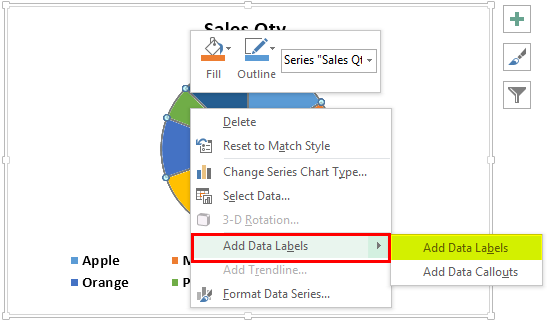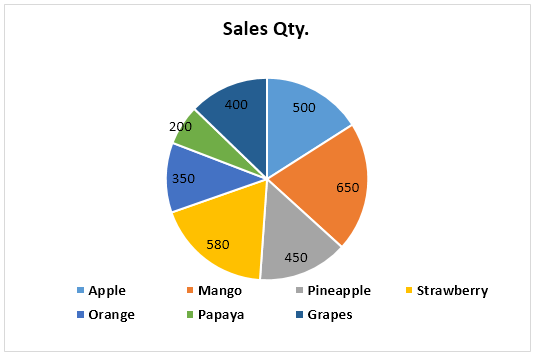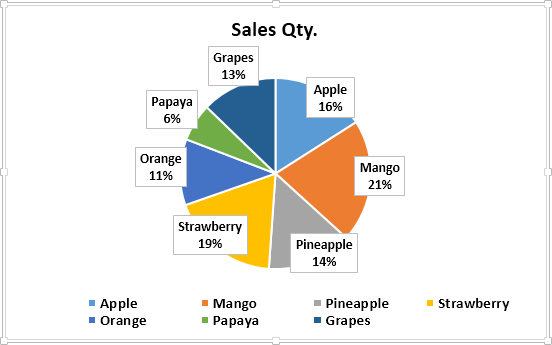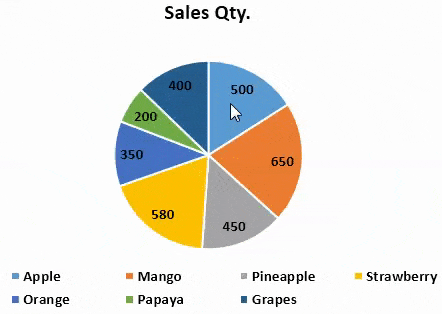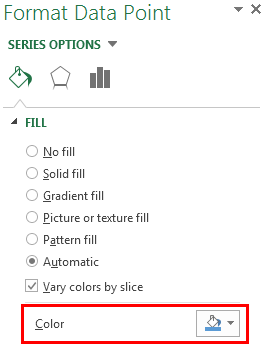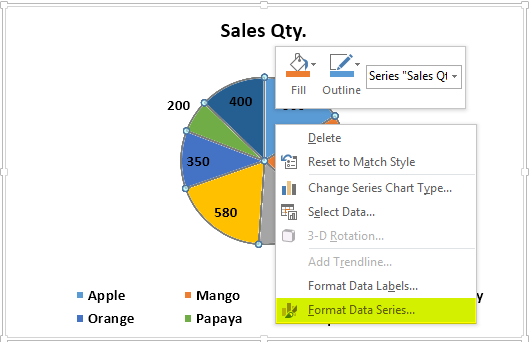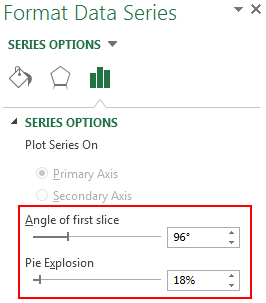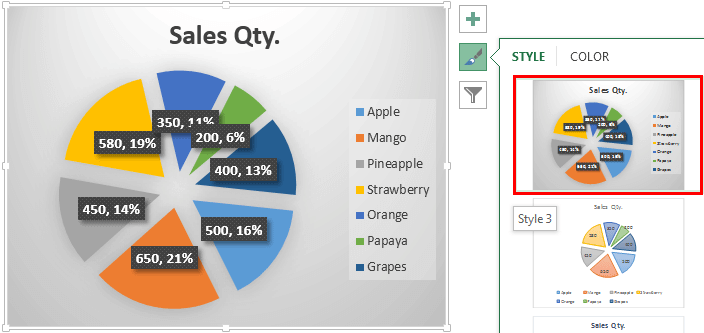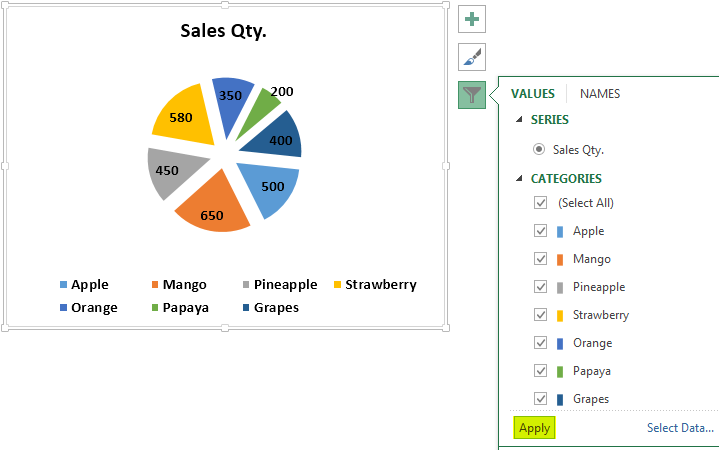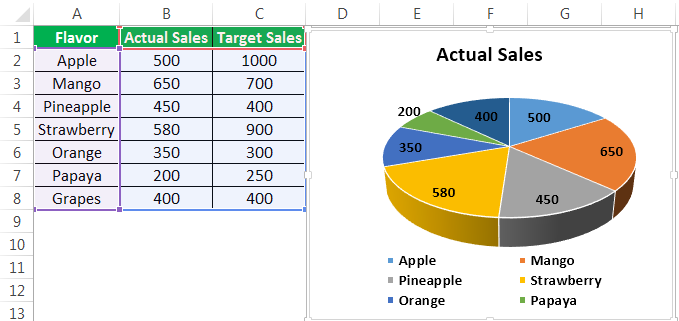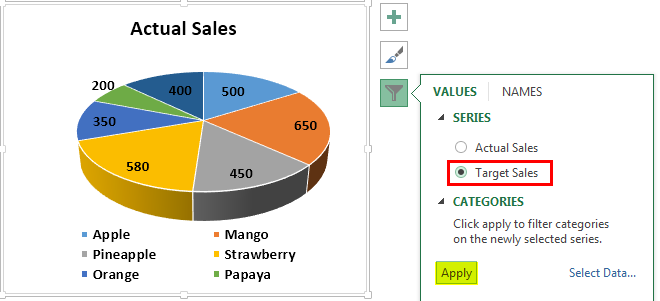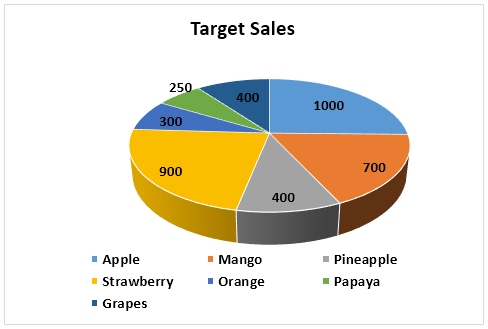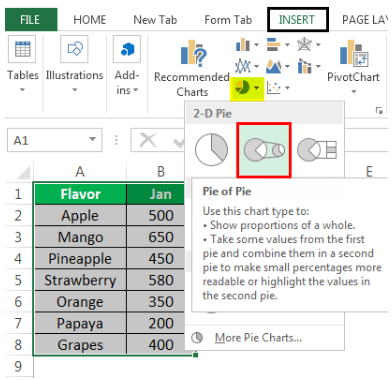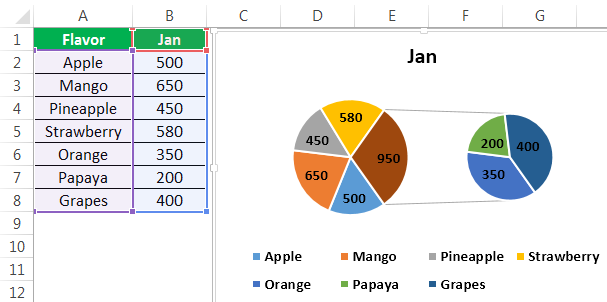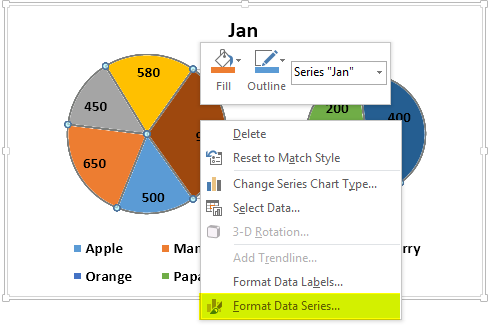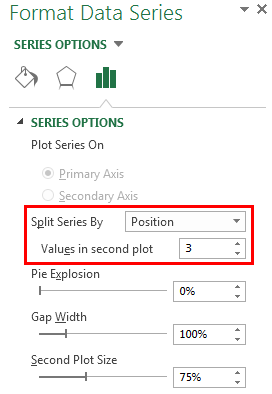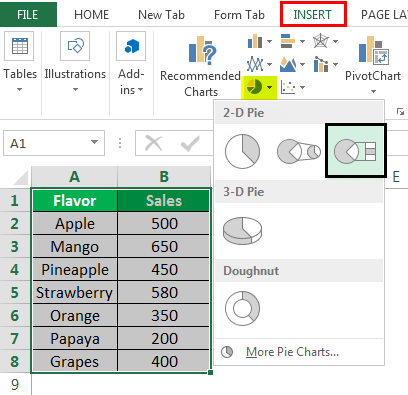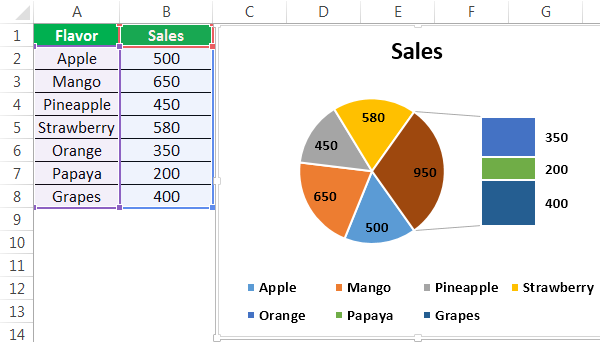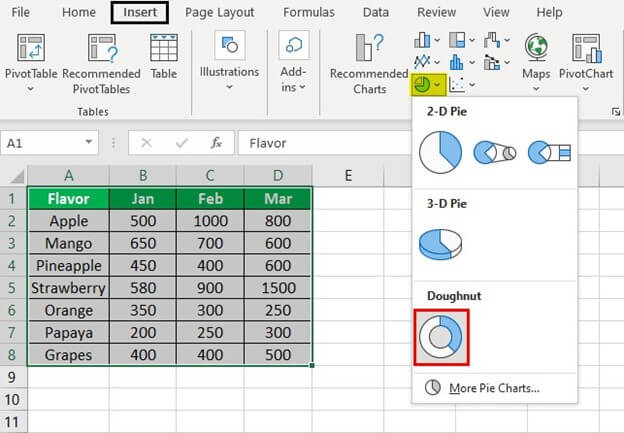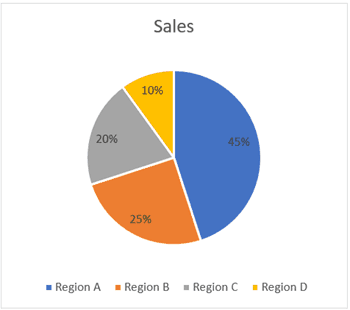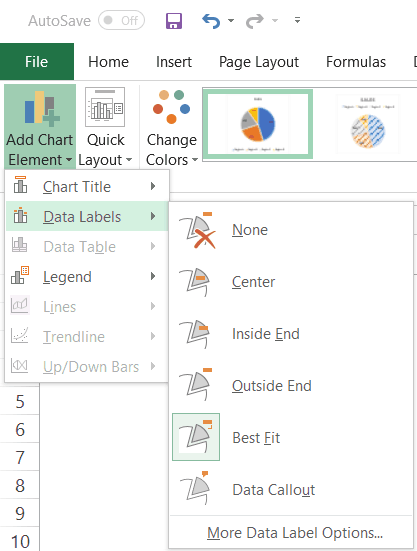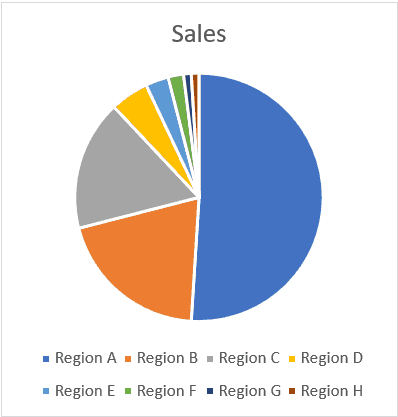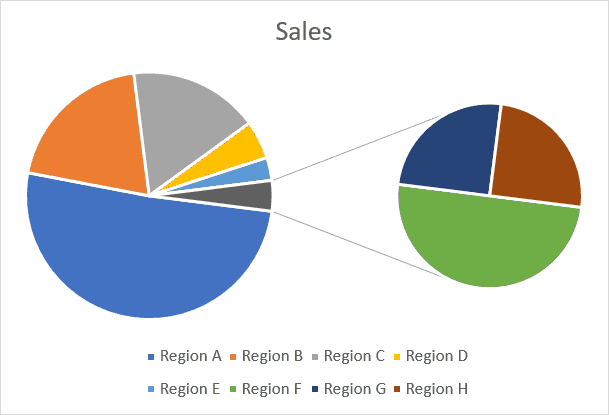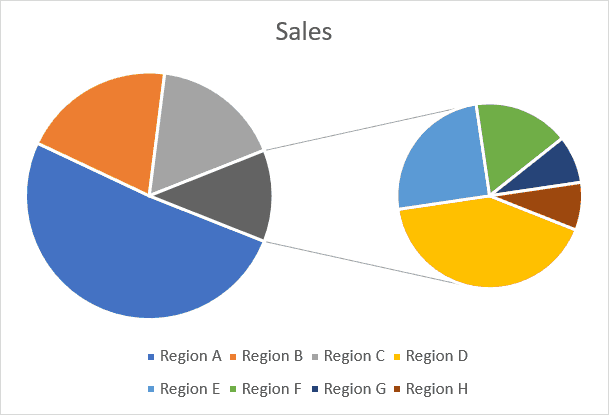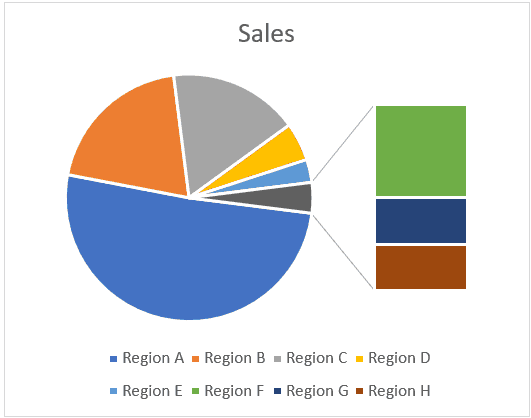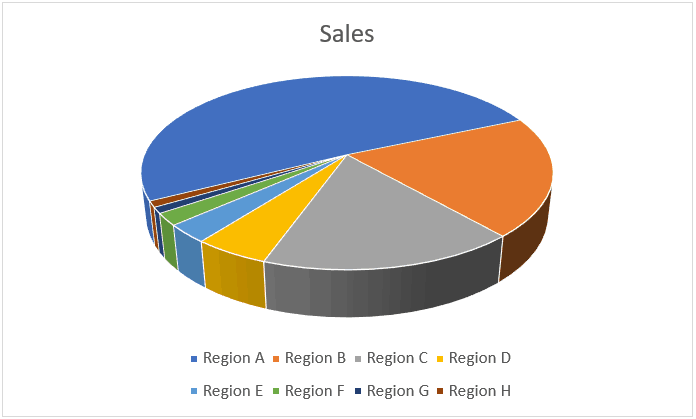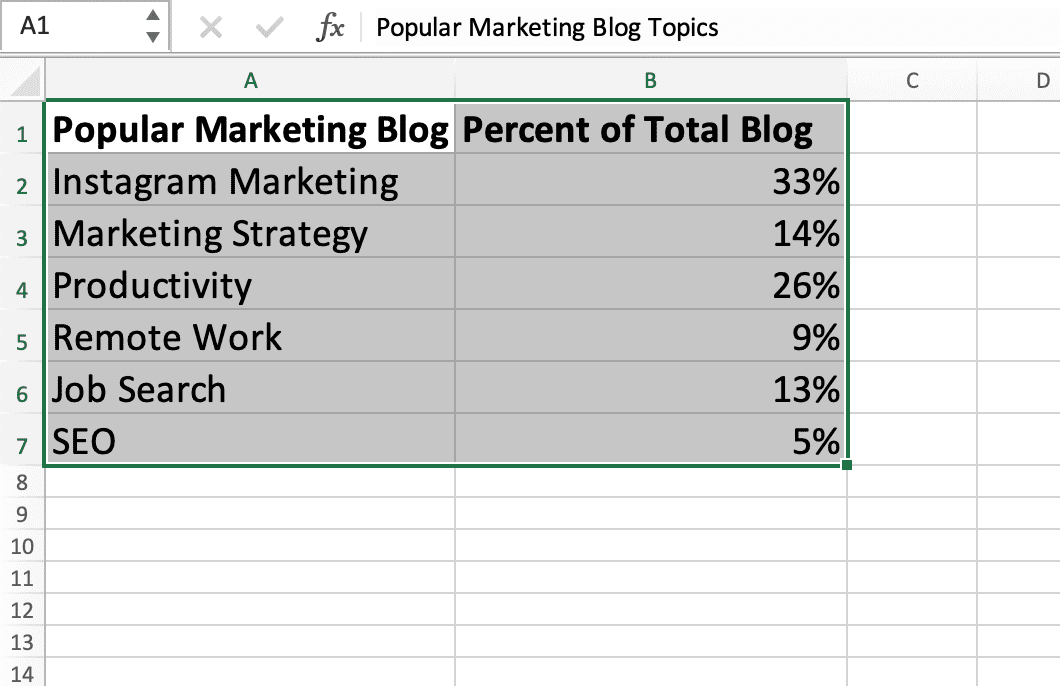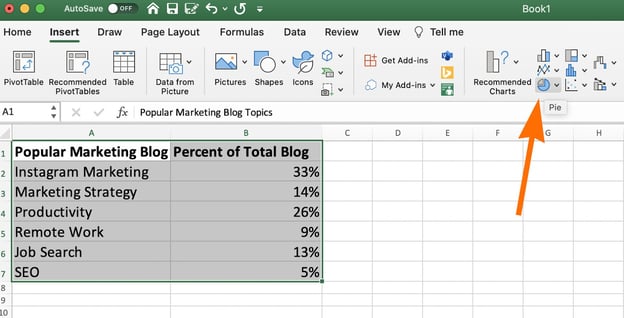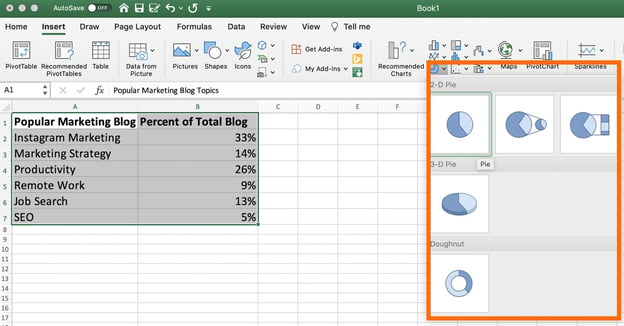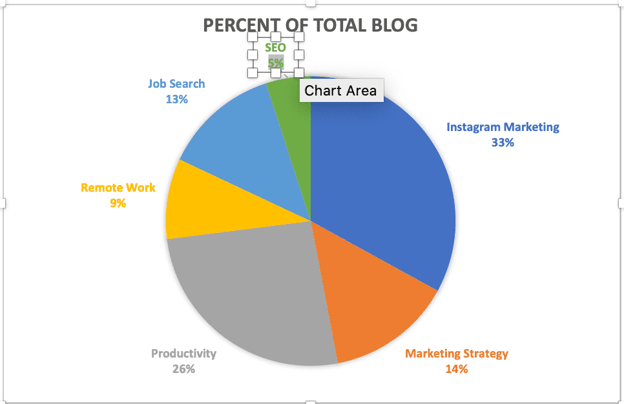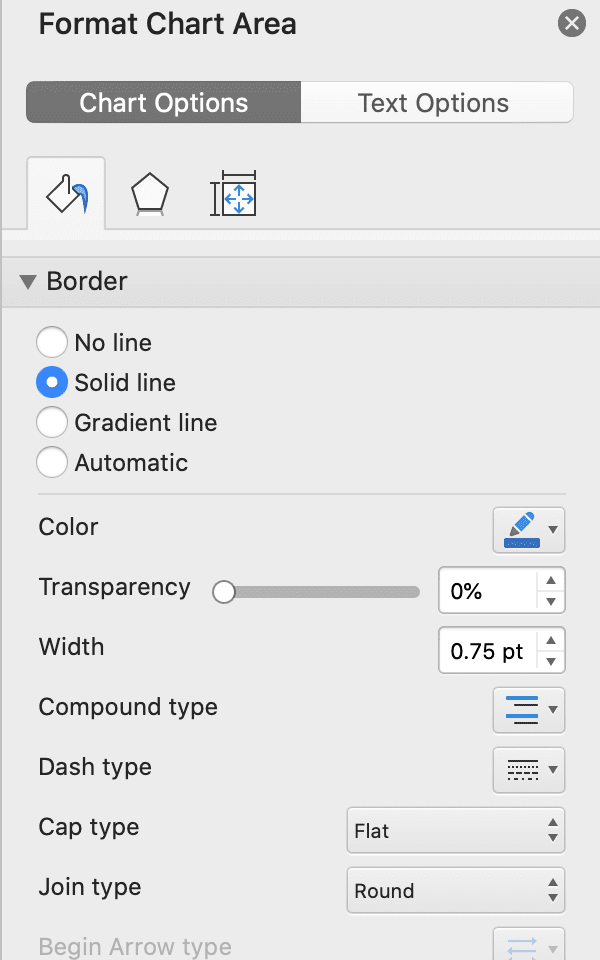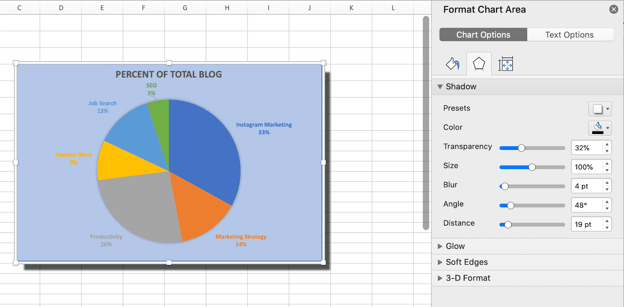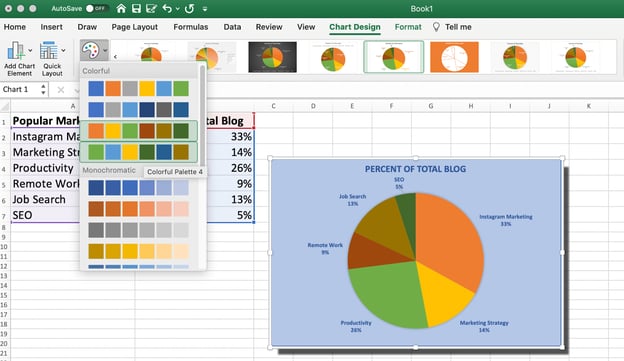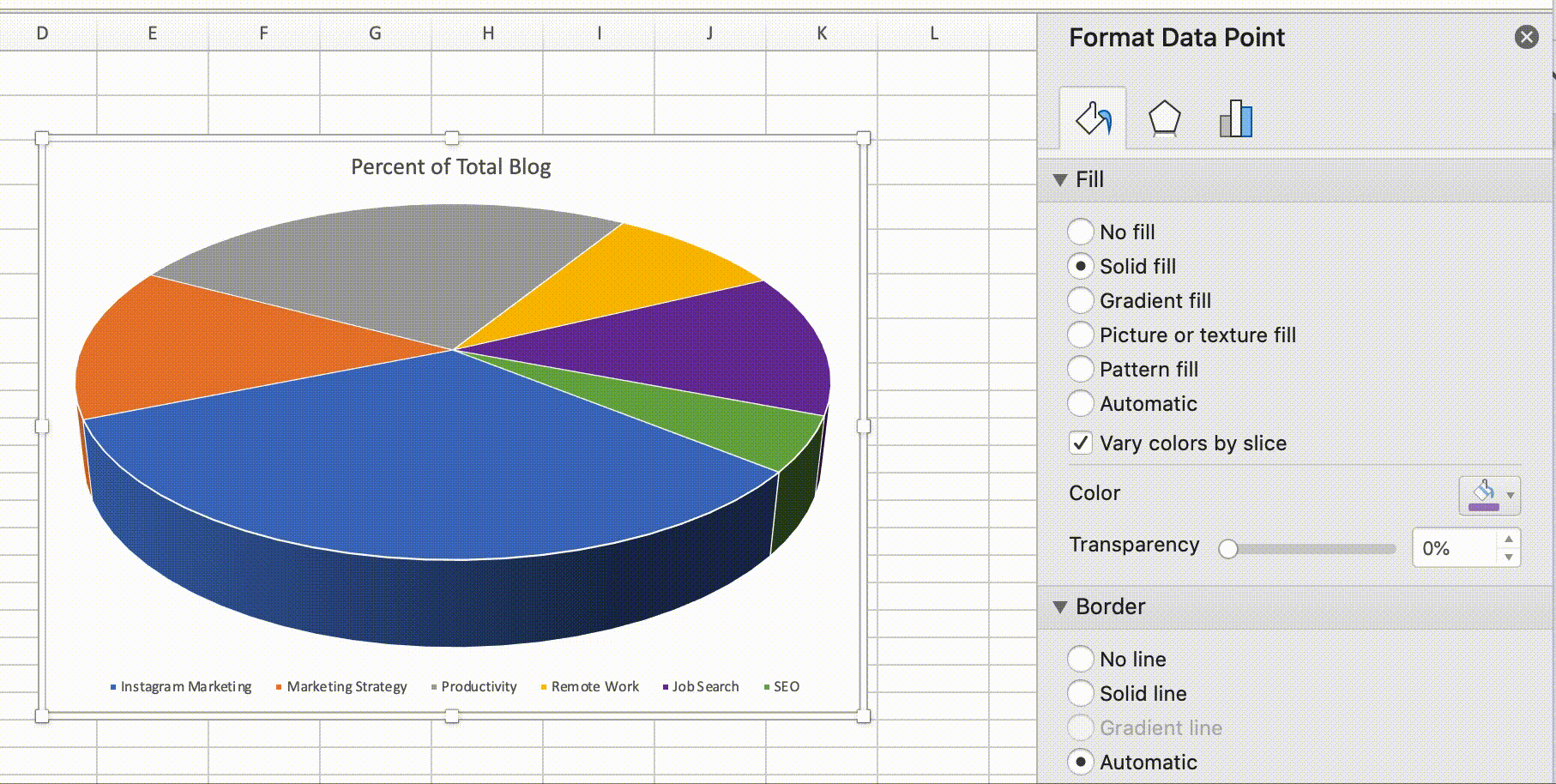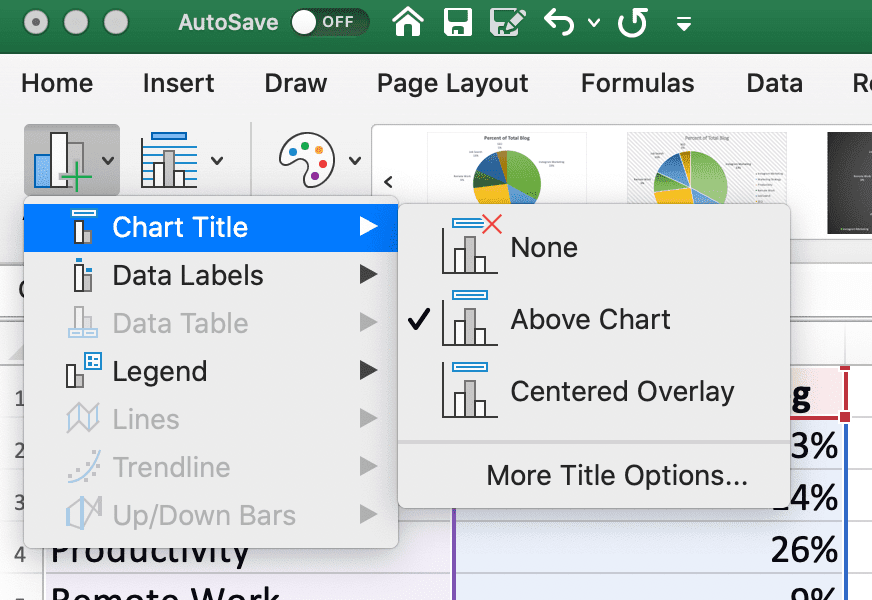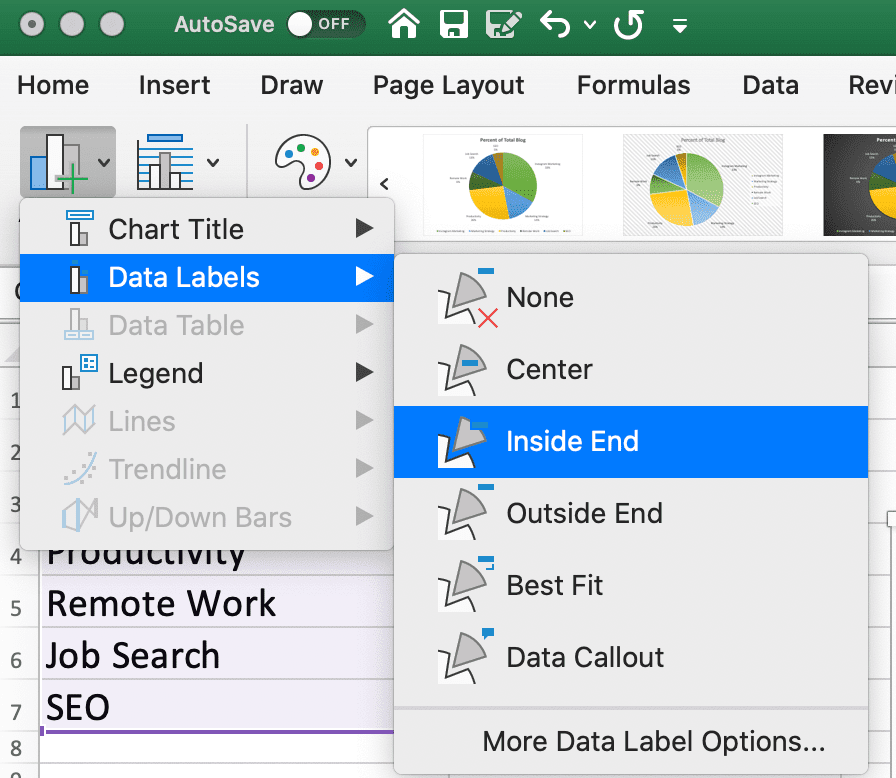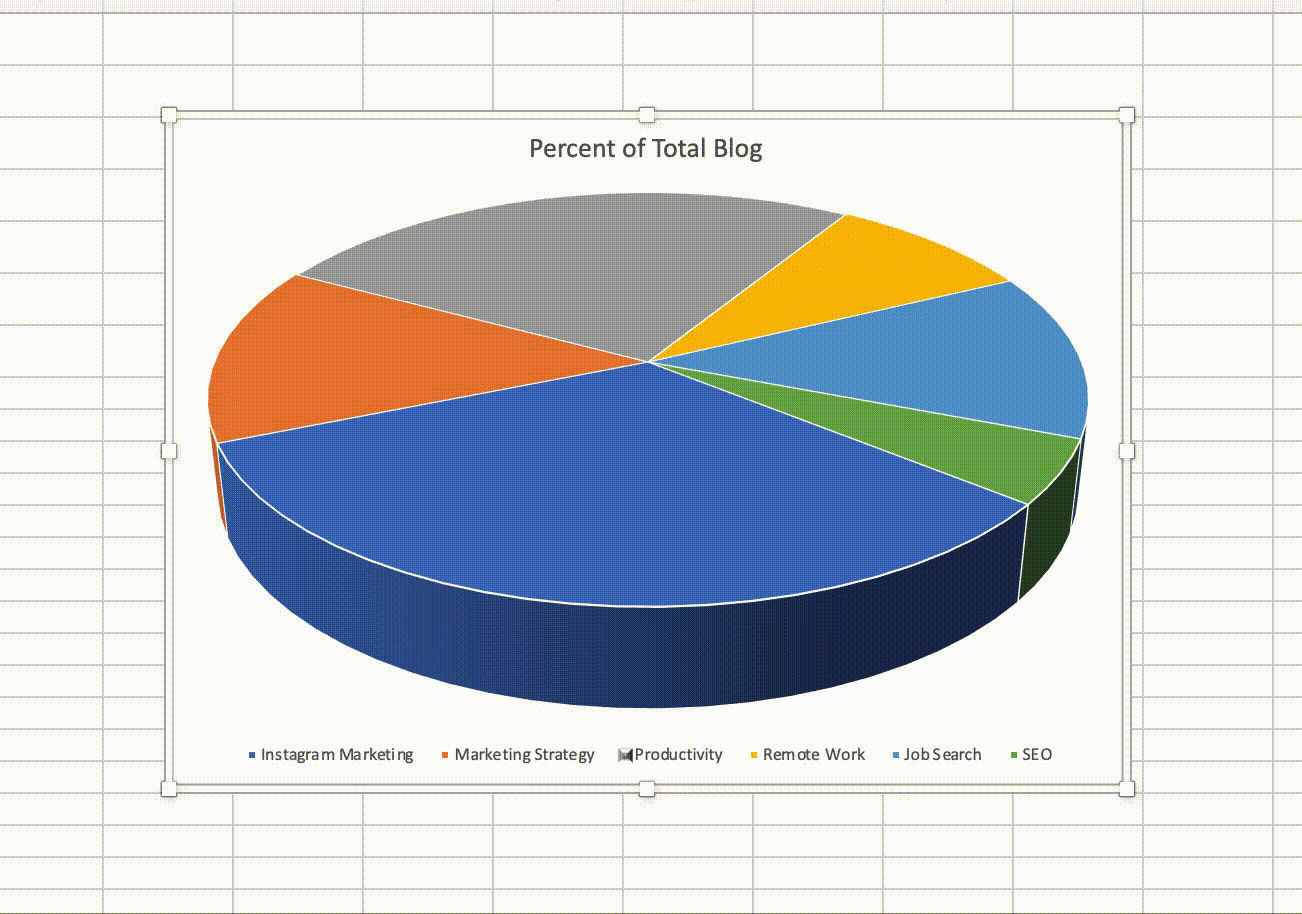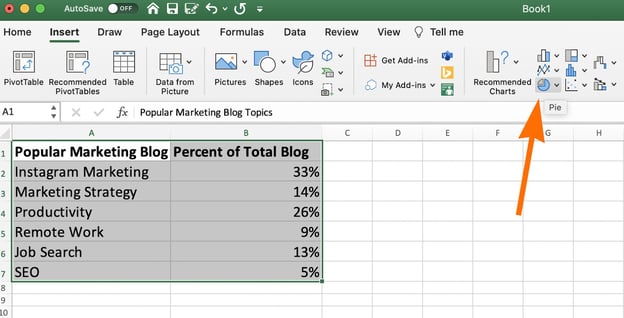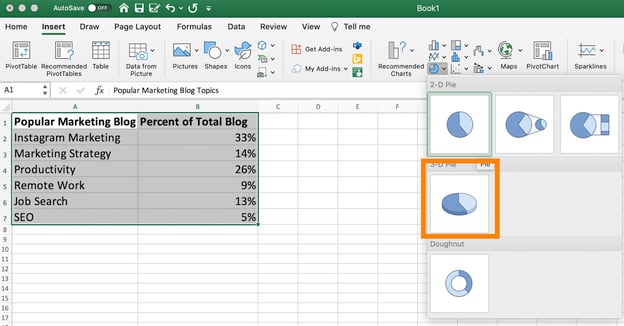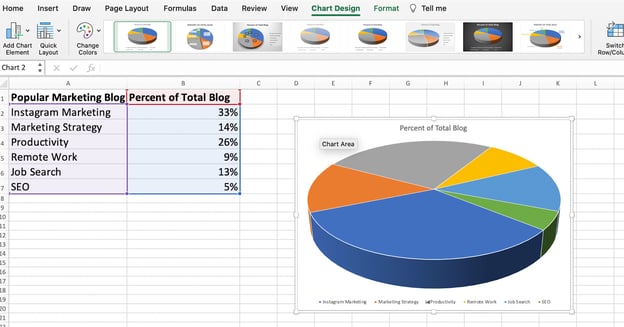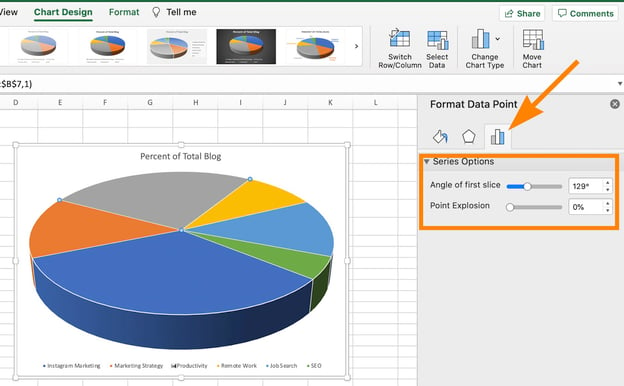Excel for Microsoft 365 Word for Microsoft 365 PowerPoint for Microsoft 365 Excel 2021 Word 2021 PowerPoint 2021 Excel 2019 Word 2019 PowerPoint 2019 Excel 2016 Word 2016 PowerPoint 2016 Excel 2013 Word 2013 PowerPoint 2013 Excel 2010 Word 2010 PowerPoint 2010 Excel 2007 Word 2007 PowerPoint 2007 More…Less
Pie charts are a popular way to show how much individual amounts—such as quarterly sales figures—contribute to a total amount—such as annual sales.
Pick your program
(Or, skip down to learn more about pie charts.)
-
Excel
-
PowerPoint
-
Word
-
Data for pie charts
-
Other types of pie charts
Note: The screen shots for this article were taken in Office 2016. If you’re using an earlier Office version your experience might be slightly different, but the steps will be the same.
Excel
-
In your spreadsheet, select the data to use for your pie chart.
For more information about how pie chart data should be arranged, see Data for pie charts.
-
Click Insert > Insert Pie or Doughnut Chart, and then pick the chart you want.
-
Click the chart and then click the icons next to the chart to add finishing touches:
-
To show, hide, or format things like axis titles or data labels, click Chart Elements
.
-
To quickly change the color or style of the chart, use the Chart Styles
.
-
To show or hide data in your chart click Chart Filters
.
-
PowerPoint
-
Click Insert > Chart > Pie, and then pick the pie chart you want to add to your slide.
Note: If your screen size is reduced, the Chart button may appear smaller:
-
In the spreadsheet that appears, replace the placeholder data with your own information.
For more information about how to arrange pie chart data, see Data for pie charts.
-
When you’ve finished, close the spreadsheet.
-
Click the chart and then click the icons next to the chart to add finishing touches:
-
To show, hide, or format things like axis titles or data labels, click Chart Elements
.
-
To quickly change the color or style of the chart, use the Chart Styles
.
-
To show or hide data in your chart click Chart Filters
.
-
Word
-
Click Insert > Chart.
Note: If your screen size is reduced, the Chart button may appear smaller:
-
Click Pie and then double-click the pie chart you want.
-
In the spreadsheet that appears, replace the placeholder data with your own information.
For more information about how pie chart data should be arranged, see Data for pie charts.
-
When you’ve finished, close the spreadsheet.
-
Click the chart and then click the icons next to the chart to add finishing touches:
-
To show, hide, or format things like axis titles or data labels, click Chart Elements
.
-
To quickly change the color or style of the chart, use the Chart Styles
.
-
To show or hide data in your chart click Chart Filters
.
-
To arrange the chart and text in your document, click the Layout Options button
.
-
Data for pie charts
Pie charts can convert one column or row of spreadsheet data into a pie chart. Each slice of pie (data point) shows the size or percentage of that slice relative to the whole pie.
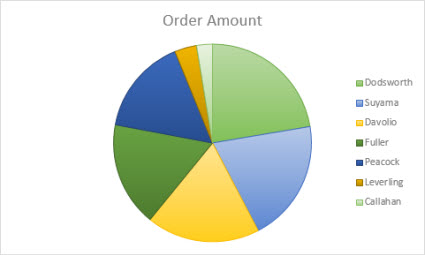
Pie charts work best when:
-
You have only one data series.
-
None of the data values are zero or less than zero.
-
You have no more than seven categories, because more than seven slices can make a chart hard to read.
Other types of pie charts
In addition to 3-D pie charts, you can create a pie of pie or bar of pie chart. These charts show smaller values pulled out into a secondary pie or stacked bar chart, which makes them easier to distinguish. To switch to one of these pie charts, click the chart, and then on the Chart Tools Design tab, click Change Chart Type. When the Change Chart Type gallery opens, pick the one you want.

See Also
Select data for a chart in Excel
Create a chart in Excel
Add a chart to your document in Word
Add a chart to your PowerPoint presentation
Available chart types in Office
Need more help?
What are Pie Charts in Excel?
A pie chart is a circular representation that reflects the numbers of a single row or single column of Excel. The individual numbers are called data points (or categories) and a list (row or column) of numbers is called a data series. Every pie chart consists of slices (or parts), which when added make a complete pie (or circle).
For example, the following image shows some pie charts of Excel. On the top, the 3-D pie chart is to the left and the Pie of Pie chart is to the right. At the bottom, the Bar of Pie chart is to the left and the Doughnut chart is to the right.
The purpose of making a pie chart in Excel is to visualize data when there are a few data points. Moreover, all the data points should belong to a specific time period. A pie chart is not suitable when there are many data points or the data points pertain to different time periods.
Table of contents
- What are Pie Charts in Excel?
- How to Make a Pie Chart in Excel?
- 2-D Pie Chart
- Example #1
- 3-D Pie Chart
- Example #2
- Pie of Pie Chart
- Example #3
- Bar of Pie Chart
- Example #4
- Doughnut Chart
- Example #5
- Frequently Asked Questions
- Recommended Articles
- 2-D Pie Chart
How to Make a Pie Chart in Excel?
Excel has different varieties of pie charts. In this article, we will learn to make the following pie charts:
- 2-D pie chart
- 3-D pie chart
- Pie of Pie chart
- Bar of Pie chart
- Doughnut chart
Let us create each Excel pie chart one by one with the help of examples.
2-D Pie Chart
A 2-D (two-dimensional) pie chart is frequently used in Excel. It is a standard pie chart that displays one slice for each data point. The bigger the number (or data point) represented by the slice, the larger the area under it.
Example #1
The following image shows the quantities sold (column B) of seven different flavors (column A) of a beverage. All the flavors of this beverage are manufactured by an organization. We want to perform the following tasks:
- Make a 2-D pie chart in Excel by taking into account the given dataset. Interpret the pie chart thus created.
- Add data labels and data callouts to the pie chart.
- Separate a few slices from the pie (or circle) and show how to change their color.
- Rotate the slices and increase the gap between them.
- Change the chart style and show how to apply filters to the pie chart in excel.
Note that the numbers pertain to a specific time period.
The tasks and the corresponding steps to be performed are listed as follows:
Task a: Make a 2-D pie chart and interpret it
Step 1: Select the entire dataset (A1:B8). Next, click the pie chart icon from the “charts” group of the Insert tab. Select a 2-D pie chart.
The selections are shown in the following image.
Step 2: A 2-D pie chart is inserted in Excel. This is shown in the following image.
Notice that the caption (on top) and the legend (at the bottom) are automatically added to the chart. The caption of the chart is the same as the heading of column B. The legend reflects all the flavors of column A.
Interpretation of the 2-D pie chart: Each slice of the chart displays the number of beverages sold in a particular time period. One slice represents one flavor of the beverage. When all the slices are added, a complete pie is obtained. So, the entire pie represents the total of column B, which is 3130.
Observe that the slice of mango (orange colored) is the biggest, while that of papaya (green colored) is the smallest. This is because the sales of mango (650) are the maximum and that of papaya (200) are the least. The second highest sales are of the strawberry flavor (580).
Hence, one can interpret that the mango flavor of the beverage has the highest demand. In contrast, the papaya flavor is not much preferred by the customers of the organization.
Task b: Add data labels and data callouts
Step 3: Right-click the pie chart and expand the “add data labels” option. Next, choose “add data labels” again, as shown in the following image.
Step 4: The data labels are added to the chart, as shown in the following image. With these labels, the sales quantity of each flavor is displayed on the respective slice. Thus, data labels make it easy to read and interpret an excel pie chart.
Note: Data labels are directly linked to the data points of the source dataset. Therefore, the data labels automatically update with a change in the data points.
Step 5: Right-click the pie chart again. Click the arrow of “add data labels” and select “add data callouts.” The data callouts have been added in the following image.
Notice that each slice shows the name of the flavor along with its share in the entire pie. Since the share is in percentage, a glance at the pie chart can suggest the highly preferred and the less preferred flavors. The total of the pie is 100%.
Task c: Separate the slices from the pie (or circle) and show how to change their color
Step 6: Select the slice to be separated and drag it away from the pie with the help of the mouse pointer. In the following image, the slices having the maximum (orange colored) and the minimum sales (green colored) have been separated from the pie.
Note: To join the slices to the pie again, drag them back to their position. Alternatively, press the undo shortcut “Ctrl+Z.”
Step 7: Double-click the slice whose color is to be changed. Next, right-click it and select the option “format data point” from the context menu. This option is shown in the following image.
Step 8: The “format data point” pane opens, as shown in the following image. In the “fill” tab, the “automatic” and “vary colors by slice” options are selected by default.
If the “color” option is visible (shown within the red box), select the desired color from it. If the “color” option is not visible, select “solid fill” and then choose the desired color. Next, close the “format data point” pane.
The selected color will be applied to the slice that was double-clicked in the preceding step.
Note: One can highlight the important slices and assign dull colors to the remaining ones. So, the small and non-relevant slices can be filled with lighter colors. This helps focus on specific data points.
Task d: Rotate the slices and increase the gap between them
Step 9: Select the pie chart and right-click it. Choose “format data series” from the context menu. This option is shown in the following image.
Step 10: The “format data series” pane opens, as shown in the following image. In the “series options” tab, perform the following actions:
- In “angle of first slice,” enter 96◦ (96 degrees).
- In “pie explosion,” enter 18% (18 percent).
Next, close the “format data series” pane.
Step 11: The slices of the pie have been rotated. Moreover, the gap between them has been increased. This is shown in the following image.
Notice that the entire pie has been rotated. So, the slice that was earlier on the top-right has moved to the bottom-right. However, the colors of the slices have not been impacted.
Task e: Change the chart style and show how to apply filters to the pie chart
Step 12: Click the pie chart. Three icons will appear on the top-right side of the chart. Next, perform the following actions:
- Click the “chart styles” button or the paintbrush icon.
- Select the desired style from the “style” tab.
Notice the changed chart style in the following image.
When the cursor is hovered over the different chart styles, a preview is shown in Excel. So, the preview helps see the way the pie chart would look if the respective style is selected.
Step 13: Click the “chart filters” button (or the filter icon) displayed on the top-right side of the chart.
In the “values” tab (shown in the following image), all the flavors of the beverage are shown under “categories.” The single column (column B) used to create the excel pie chart is reflected under “series.”
Select or deselect the categories in order to show or hide them from the chart. Next, click “apply” shown at the bottom-left side of the “values” tab. The filters will be applied to the pie chart.
3-D Pie Chart
A 3-D (three-dimensional) pie chart is usually used for decorative purposes. The features of a 3-D pie chart are similar to that of a 2-D pie chart. However, a 3-D pie chart has an additional feature called 3-D rotation, which is not there in a 2-D pie chart.
It is not recommended to use a 3-D pie chart for data visualization. The reason is that the numbers represented by the chart may look larger than they actually are. So, a 3-D pie chart can be confusing and misleading due to its 3-D effect.
Example #2
Working on the dataset of example #1, we have changed the heading of column B to “actual sales.” Moreover, the sales numbers targeted by the organization have been added in column C. We want to perform the following tasks:
- Show the outcome when a 3-D pie chart is created by considering the entire dataset. In total, there should be two 3-D pie charts. They should reflect the numbers of both columns (columns B and C) one by one.
- Interpret the 3-D pie excel charts thus created.
The steps to perform the given tasks are listed as follows:
Step 1: Select the entire dataset (A1:C8) including columns B and C. From the Insert tab, click the pie chart icon (in the “charts” group) and choose a 3-D pie chart.
The selections are shown in the following image. Notice that the column headings have also been selected before inserting the excel pie chart. This is because we want the name of the column to be displayed as the title of the chart.
Step 2: A 3-D pie chart has been created, as shown in the following image. The data labels have been added to the pie chart the same way they were added in task “b” of example #1.
Notice that though we selected the entire dataset (in the preceding step), the pie chart displays only the numbers of column B. The reason is that a pie chart can show only a single series at a time. So, by default, Excel is displaying the first (column B) of the two series (columns B and C).
Step 3: Filter the series of the pie chart to show the numbers of column C. For filtering, perform the listed actions:
- Click the pie chart. Three icons appear on the top-right side of the chart.
- Click the “chart filters” button (or the filter icon), which is the third of the three icons.
- In the “values” tab, the “series” and “categories” are displayed. Select the series “target sales.”
- Click “apply.”
The selection of the series “target sales” is shown in the following image.
Step 4: A 3-D pie chart reflecting the numbers of column C has been created. This is shown in the following image. The data labels have been added by right-clicking the chart and choosing “add data labels.”
Interpretation of the two 3-D pie charts: The numbers of column B are reflected in the “actual sales” chart (in step 2), while those of column C are reflected in the “target sales” chart (in step 4). There are two charts because a pie chart can display a single data series at one time.
To facilitate comparison, one must place the two pie charts in excel next to each other. On a comparison between the two charts, one can observe that the actual sales of two flavors (pineapple and orange) have exceeded the target sales.
For the grapes flavor, the actual and target sales are the same. However, for all the remaining flavors, the targeted sales volume is more than the actual sales volume. Consequently, the organization must focus on pushing the actual numbers closer to the targeted numbers. Thus, a revision of the marketing plan may be required.
Pie of Pie Chart
A Pie of Pie chart displays an additional pie along with the main pie. This additional pie (or secondary pie) shows the breakup of one slice of the main pie. By default, Excel displays the last three data points of a series on the secondary pie. To avoid this, either of the following actions can be carried out:
- Sort the data series in a descending order. By sorting, the smallest three data points of the series are moved to the secondary pie.
- Choose the data points that will be moved to the secondary pie. For making this choice, the “format data series” panel is used.
A Pie of Pie chart enhances the readability of the main pie by moving the smaller slices to the secondary pie. As a result, the user can focus on the slices of both pies, thereby making the chart easy to interpret and analyze. Moreover, with the division of slices (of the main pie), a Pie of Pie chart can handle more data points than a regular pie chart.
Note: To know how to use the “format data series” panel in the second bullet point, refer to the following example.
Example #3
Working on the dataset of example #1, we have changed the heading of column B to “Jan.” So, consider that the figures of this column pertain to the month of January of a certain year. Perform the following tasks:
- Make a Pie of Pie chart where the secondary pie displays the last three numbers (or data points) of the dataset. Further, interpret the Pie of Pie chart thus created.
- Show how the “format data series” panel is used to decide which data points to be displayed on the secondary pie.
The tasks and the steps to be performed are listed as follows:
Task a: Make a Pie of Pie chart and interpret it
Step 1: Select the entire dataset (A1:B8). From the Insert tab, click the pie icon appearing in the “charts” group. Choose the Pie of Pie chart from 2-D pie charts.
The selections are shown in the following image.
Step 2: The Pie of Pie chart is created, as shown in the following image. Notice that by default, Excel has moved the last three data points (350, 200, and 400) of the series to the secondary pie.
Interpretation of the Pie of Pie chart: There are 7 numbers in column B of the given dataset. The main pie shows five slices which consist of the first four data points (500, 650, 450, and 580) and the total of the last three data points (350+200+400=950).
Further, the slice showing the number 950 is the largest part of the main pie. This part is joined to the secondary pie with two grey lines. Notice that the last three data points moved to the secondary pie are smaller than the other data points. With this division of data points, one can easily focus on both pies at a given time.
So, the main pie can be studied to improve the demand for the preferred flavors (apple, mango, pineapple, and strawberry). In contrast, the secondary pie can be analyzed to identify the causes of low demand for the unpopular flavors (orange, papaya, and grapes).
Task b: Choose the data points to be displayed on the secondary pie
Step 3: Select the Pie of Pie chart and right-click it. Choose the option “format data series” from the context menu. This option is shown in the following image.
Step 4: The “format data series” pane opens, as shown in the following image. By default, the “split series by” drop-down list shows “position.” The option “position” tells Excel the number of data points to be moved to the secondary pie.
The “values in second plot” box shows 3. This implies that the last three data points will be moved to the secondary pie. This number (3) can be increased or decreased to add or reduce the number of slices of the secondary pie.
With the default selections (shown in the following image), the Pie of Pie chart looks the same as that of step 2 of this example. However, if we enter 4 in the “values in second plot” box, the slice representing the quantity 580 (fourth last data point) will also move to the secondary pie.
Note: The different options of the “split series by” drop-down list are explained as follows:
- “Value” or “percentage value”–These options allow specifying the minimum value or percentage below which the data points will be moved to the secondary pie.
- “Custom”–This option allows selecting a particular slice of the pies manually. Then, one can specify whether this slice should be displayed on the main or secondary pie.
Bar of Pie Chart
The Bar of Pie chart displays a stacked bar along with the pie. The bar shows the breakup of one of the slices of the pie. Moreover, the bar consists of segments that represent data points and are stacked one over the other.
Similar to the Pie of Pie chart, the last three data points of a series are shown on the bar by default. To move the smallest three data points to the bar, one can sort the series in a descending order.
One can also choose the slices or segments (or data points) to be shown on the pie and bar. The slices to be displayed are chosen with the help of the “format data series” pane. This pane works the same way it did for the Pie of Pie chart.
A Bar of Pie chart improves the readability of the pie and bar, thereby helping the user to focus on all the data points of a series.
Example #4
Working on the dataset of example #1, we have titled column B as “sales.” Create a Bar of Pie chart and interpret it.
The steps to create a Bar of Pie chart are listed as follows:
Step 1: Select the entire dataset (A1:B8). Click the pie icon from the “charts” group of the Insert tab. From 2-D pie charts, choose the Bar of Pie chart.
The Bar of Pie chart option is shown within a black box in the following image.
Step 2: The Bar of Pie chart is inserted, as shown in the following image. Notice that by default, the last three data points (350, 200, and 400) have been moved to the bar displayed on the right side of the pie.
Interpretation of the Bar of Pie chart: The pie represents the first four data points (500, 650, 450, and 580) of the series (of column B) along with the total of the last three data points (350+200+400=950).
The biggest slice of the pie is the brown one. It represents the number 950. This slice is connected to the bar with the help of grey lines. Notice that the bigger the number, the larger the segment of the bar. In other words, the larger the segment of the bar or the bigger the slice of the pie, the higher the quantity sold of that flavor.
Therefore, the pie shows the highly preferred flavors while the bar shows the less preferred ones. The green segment (papaya) of the bar is the least preferred as its area is the smallest. So, the organization needs to boost sales of the flavors that are not much preferred by its customers.
Doughnut Chart
A doughnut chartA doughnut chart is a type of excel chart whose visualization is similar to pie chart. The categories in this chart are parts that, when combined, represent the whole data in the chart. A doughnut chart can only be made using data in rows or columns.read more is a variant of the pie chart of Excel. However, the former is different from the latter in the sense that it can contain more than one data series. Moreover, a doughnut chart consists of rings instead of slices. Further, each ring consists of arcs. The innermost ring of the chart represents the first data series.
A doughnut chart is hollow on the inside. It is difficult to read and interpret a doughnut chart compared to a regular excel pie chart. From Excel 2016, sunburst charts have been introduced, which are more preferred than doughnut charts.
Example #5
Working on the dataset of example #1, we have labeled column B as “Jan.” This column shows the sales of January. We have also added the sales of February and March to columns C and D respectively.
In total, there are three series (Jan, Feb, and Mar) in the dataset. Perform the following tasks:
- Create a doughnut chart by considering the entire dataset.
- Title the chart as “Doughnut Pie Chart.”
- Show the doughnut chart with an enlarged hole.
- Interpret the chart thus created.
The steps to perform the given tasks are listed as follows:
Step 1: Select the entire dataset (A1:D8). Click the pie icon from the Insert tab of Excel. Choose “doughnut” under the doughnut charts.
The selection is shown in the following image.
Note: In Excel 2007, click the “other charts” drop-down (in the “charts” group) from the Insert tab. Next, select “doughnut” under the doughnut charts.
Step 2: A doughnut chart is inserted in Excel, as shown in the following image. The “chart title” text box may or may not appear (by default) on top of the chart. If the “chart title” text box does not appear, perform the following actions:
- Click anywhere on the doughnut chart. The “chart tools” menu of the Excel ribbon becomes visible. It consists of the Design and Format tabs.
- Click “add chart element” from the Design tab.
- From “chart title,” select either “above chart” or “centered overlay.” A default text box consisting of “chart title” appears.
- Type the desired title within the text box.
- Click outside the text box to fix the new title to the chart.
If the “chart title” text box does appear, type “Doughnut Pie Chart” within it. Next, follow action “e” listed above.
To enlarge the hole of the doughnut chart, perform the following actions:
- Right-click any data series and choose “format data series” from the context menu. The “format data series” pane opens.
- In the “series options” tab, there is a slider under “doughnut hole size.” Move this slider to the right to increase the size of the hole. Alternatively, enter a percentage between 10 and 90 in the box. We have entered 75%.
The chart title and the enlarged hole are shown in the following image.
Note: In Excel 2007, the “chart tools” menu shows the Design, Layout, and Format tabs. To add a title to the chart, click the “chart title” drop-down (in “labels” group) from the Layout tab. Next, follow steps “c,” “d,” and “e” listed under the first set of actions.
Interpretation of the Doughnut chart: The innermost ring of the chart represents the series “Jan.” The middle and the outer rings represent the series “Feb” and “Mar” respectively.
Each data point is represented by an arc in place of a slice. So, one can say that the bigger the number (or data point), the larger the arc representing it. In each ring, there are seven arcs for the seven flavors.
Notice that the flavor papaya has a small arc (in green) in all the three rings. However, just by looking at the chart, one cannot ascertain the numbers represented by the different arcs. Further, had we added data labels to all the three rings, the chart would have become cluttered. For these reasons, a regular pie chart is preferred over a doughnut chart.
Frequently Asked Questions
1. Define a pie chart and suggest how to make it in Excel.
A pie chart shows the data points of a single data series. It is a circular chart consisting of slices. One slice represents one data point. The entire pie represents the total of the individual data points. Zeroes and negative values cannot be depicted on a pie chart.
To create a pie chart in Excel, follow the listed steps:
a. Arrange the data series in a single row or single column of Excel.
b. Select the entire dataset including the row and column headings as well as the data series.
c. Click the pie icon from the “charts” group of the Insert tab.
d. Select the required pie chart like a 2-D pie chart, 3-D pie chart, Pie of Pie chart, and so on.
The pie chart selected in step “d” is inserted in Excel.
Note: For more details on the different types of pie charts, refer to the definitions and examples given in this article.
2. How to make a pie chart showing percentages in Excel?
To create a pie chart showing percentages, follow either of the listed methods:
• Method 1–Enter the numbers (or data points) as percentages in the data series. These percentages will appear as data labels on the pie chart. For adding such data labels, right-click the pie chart and choose “add data labels” from the context menu.
• Method 2–Enter numbers as is in the series and let Excel convert them to percentages. Once converted, the numbers and percentages will appear as data labels on the pie chart. The steps to display such data labels are listed as follows:
a. Right-click any slice of the pie chart and choose “format data labels” from the context menu. The “format data labels” pane opens.
b. From the “label options” tab, select “value” and “percentage” under “label contains.”
c. Close the “format data labels” pane.
Note: In both methods, the sum of all the data points (or the total value) need not necessarily be 100%. If this sum is not 100%, the outcomes are stated as follows:
• In method 1, each slice of the pie represents a percentage of the total value. The sum of all slices (or data points) of the pie is any value other than 100%.
• In method 2, Excel automatically makes the sum of all slices of the pie 100%. So, the percentage represented by each slice is calculated from the total of 100%.
3. How to create a pie chart using multiple columns of Excel? Suggest how to resize a pie chart in Excel.
It is not possible to create a pie chart using multiple columns or multiple data series. The reason is that a regular pie chart displays the data points (or categories) of a single data series only. So, only a single row or a single column can be used as the source dataset of a pie chart.
To display the data points of multiple data series, the doughnut chart can be used as a variant of the regular pie chart.
The steps to resize an excel pie chart are listed as follows:
a. Click anywhere on the pie chart. The “chart tools” menu appears on the Excel ribbon.
b. Click the “format” tab from the “chart tools” menu.
c. Type the required size in the “height” and “width” boxes displayed in the “size” group.
d. Press the “Enter” key.
Note: Alternatively, increase or decrease the size of the pie chart by using the arrows of the “height” and “width” boxes.
Recommended Articles
This has been a guide to making Pie chart in Excel. Here we discuss how to make the top five types of pie charts, namely, 2-D, 3-D, Pie of Pie, Bar of Pie, and Doughnut chart. You may learn more about Excel from the following articles–
- Excel Rotate Pie Chart
- Create Control Charts in Excel
- Excel Stock Chart
- Create 3D Maps in Excel
Excel has a variety of in-built charts that can be used to visualize data. And creating these charts in Excel only takes a few clicks.
Among all these Excel chart types, there has been one that has been a subject of a lot of debate over time.
…the PIE chart (no points for guessing).
Pie charts may not have got as much love as it’s peers, but it definitely has a place. And if I go by what I see in management meetings or in newspapers/magazines, it’s probably way ahead of its peers.
In this tutorial, I will show you how to create a Pie chart in Excel.
But this tutorial is not just about creating the Pie chart. I will also cover the pros & cons of using Pie charts and some advanced variations of it.
Note: Often, a Pie chart is not the best chart to visualize your data. I recommend you use it only when you have a few data points and a compelling reason to use it (such as your manager’s/client’s penchant for Pie charts). In many cases, you can easily replace it with a column or bar chart.
Let’s start from the basics and understand what is a Pie Chart.
In case you find some sections of this tutorial too basic or not relevant, click on the link in the table of contents and jump to the relevant section.
What is a Pie Chart?
I will not spend a lot of time on this, assuming you already know what it is.
And no.. it has nothing to do with food (although you can definitely slice it up into pieces).
A pie chart (or a circle chart) is a circular chart, which is divided into slices. Each part (slice) represents a percentage of the whole. The length of the pie arc is proportional to the quantity it represents.
Or to put it simply, it’s something as shown below.
The entire pie chart represents the total value (which is 100% in this case) and each slice represents a part of that value (which are 45%, 25%, 20%, and 10%).
Note that I have chosen 100% as the total value. You can have any value as the total value of the chart (which becomes 100%) and all the slices will represent a percentage of the total value.
Let me first cover how to create a Pie chart in Excel (assuming that’s what you’re here for).
But I do recommend that you go on and read all the things covered later in this article as well (most importantly the Pros and Cons section).
Creating a Pie Chart in Excel
To create a Pie chart in Excel, you need to have your data structured as shown below.
The description of the pie slices should be in the left column and the data for each slice should be in the right column.
Once you have the data in place, below are the steps to create a Pie chart in Excel:
- Select the entire dataset
- Click the Insert tab.
- In the Charts group, click on the ‘Insert Pie or Doughnut Chart’ icon.
- Click on the Pie icon (within 2-D Pie icons).
The above steps would instantly add a Pie chart on your worksheet (as shown below).
While you can figure out the approximate value of each slice in the chart by looking at its size, it’s always better to add the actual values to each slice of the chart.
These are called the Data Labels
To add the data labels on each slice, right-click on any of the slices and click on ‘Add Data Labels’.
This will instantly add the values to each slice.
You can also easily format these data labels to look better on the chart (covered later in this tutorial).
Formatting the Pie Chart in Excel
There are a lot of customizations you can do with a Pie chart in Excel. Almost every element of it can be modified/formatted.
Pro Tip: It’s best to keep your Pie Charts simple. While you can use a lot of colors, keep it to a minimum (even different shades of the same color is fine). Also, if your charts are printed in black and white, you need to make sure the difference in slice colors is noticeable.
Let’s see a few of the things that you can change to make your charts better.
Changing the Style and Color
Excel already has some neat pre-made styles and color combinations that you can use to instantly format your Pie charts.
When you select the chart, it will show you the two contextual tabs – Design and Format.
These tabs only appear when you select the chart
Within the ‘Design’ tab, you can change the Pie chart style by clicking on any of the pre-made styles. As soon as you select the style that you want, it will be applied to the chart.
You can also hover your cursor over these styles and it will show you a live preview of how your Pie chart would look when that style is applied.
You can also change the color combination of the chart by clicking on the ‘Change Colors’ option and then selecting the one you want. Again, as you hover the cursor over these color combinations, it will show a live preview of the chart.
Pro Tip: Unless you want your chart to be really colorful, opt for the monochromatic options. These have shades of the same color and are relatively easy to read. Also, in case you want to highlight one specific slice, you can keep all the other slices in dull color (such as grey or light blue) and highlight that slice with a different color (preferably bright colors such as red or orange or green).
Related tutorial: How to Copy Chart (Graph) Format in Excel
Formatting the Data Labels
Adding the data labels to a Pie chart is super easy.
Right-click on any of the slices and then click on Add Data Labels.
As soon as you do this. data labels would be added to each slice of the Pie chart.
And once you have added the data labels, there is a lot of customization you can do with it.
Quick Data Label Formatting from the Design Tab
A quick level of customization of the data labels is available in the Design tab, which becomes available when you select the chart.
Here are the steps to format the data label from the Design tab:
- Select the chart. This will make the Design tab available in the ribbon.
- In the Design tab, click on the Add Chart Element (it’s in the Chart Layouts group).
- Hover the cursor on the Data Labels option.
- Select any formatting option from the list.
One of the options that I want to highlight is the ‘Data Callout’ option. It quickly turns your data labels into callouts as shown below.
More data label formatting options become available when you right-click on any of the data labels and click on ‘Format Data Labels.
This will open a ‘Format Data Labels’ pane on the side (or a dialog box if you’re using an older version of Excel).
In the Format Data Labels pane, there are two sets of options – Label Options and Text Options
Formatting the Label Options
You can do the following type of formatting with the label options:
- Give a border to the label(s) or fill the label(s) box with a color.
- Give effects such as Shadow, Glow, Soft Edges, and 3-D Format.
- Change the size and alignment of the data label
- Format the label values using the Label options.
I recommend keeping the default data label settings. In some cases, you may want to change the color or the font size of these labels. But in most cases, the default settings are fine.
You can, however, make some decent formatting changes using the label options.
For example, you can change the placement of the data label (which is ‘best fit’ by default) or you can add the percentage value for each slice (which shows how much percentage of the total does each slice represents).
Formatting the Text Options
Text Options formatting allows you to change the following:
- Text Fill and outline
- Text Effects
- Text box
In most cases, the default settings are good enough.
The one setting you may want to change is the data label text color. It’s best to keep a contrasting text color so it’s easy to read. For example, in the below example, while the default data label text color was black, I changed it to white to make it readable.
Also, you can change the font color and style by using the options in the ribbon. Just select the data label(s) you want to format and use the formatting options in the ribbon.
Formatting the Series Options
Again, while the default settings are enough in most cases, there are few things you can do with ‘Series Options’ formatting that can make your Pie charts better.
To format the series, right-click on any of the slices of the Pie chart and click on ‘Format Data Series’.
This will open a pane (or a dialog box) with all the series formatting options.
The following formatting options are available:
- Fill & Line
- Effects
- Series Options
Now let me show you some minor formatting that you can do to make your Pie chart look better and more useful for the reader.
Formatting the Legend
Just like any other chart in Excel, you can also format the legend of a Pie chart.
To format the legend, right-click on the legend and click in Format Legend. This will open the Format Legend pane (or a dialog box)
Within the Format Legend options, you have the following options:
- Legend Options: This will allow you to change the formatting such as fill color and line color, apply effects, and change the position of the legend (which allows you to place the legend at the top, bottom, left, right and top right).
- Text Options: These options allow you to change the text color and outline, text effects, and the text box.
In most cases, you don’t need to change any of these settings. The only time I use this is when I want to change the position of the legend (place it on the right instead of the bottom).
Pie Chart Pros and Cons
Although Pie charts are used a lot in Excel and PowerPoint, there are some drawbacks about it that you should know.
You should consider using it only when you think it allows you to represent the data in an easy to understand format and adds value for the reader/user/management.
Let’s go through the Pros and Cons of using Pie charts in Excel.
Let’s start with the good things first.
What’s Good about Pie Charts
- Easy to create: While most of the charts in Excel are easy to create, pie charts are even easier. You don’t need to worry a lot about customization as most of the times, the default settings are good enough. And if you need to customize it, there are many formatting options available.
- Easy to read: If you only have a few data points, Pie charts can be very easy to read. As soon as someone looks at a Pie chart, they can figure out what it means. Note that this works only if you have a few data points. When you have a lot of data points, the slices get smaller and become hard to figure out
- Management loves Pie Charts: In my many years of corporate career as a financial analyst, I have seen the love managers/clients have for Pie charts (which is probably only trumped by their love for coffee and PowerPoint). There have been instances, where I have been asked to convert bar/column charts into Pie charts (as people find it more intuitive).
If you’re interested, you can also read this article by Excel charting expert Jon Peltier on why we love pie charts (disclaimer: he doesn’t)
What’s Not so Good About Pie Charts
- Useful Only with fewer data points: Pie charts can become quite complex (and useless to be honest) when you have more data points. The best use of a Pie chart would be to show how one or two slices are doing as a part of the overall pie. For example, if you have a company with five divisions, you can use a Pie chart to show the revenue percent of each division. But if you have 20 divisions, it may not be the right choice. Instead, a column/bar chart would be better suited.
- Can’t show a trend: Pie charts are meant to show you the snapshot of the data in a given point in time. If you want to show a trend, better use a line chart.
- Can’t show multiple types of data points: One of the things I love about Column charts is that you can combine it with a line and create combination charts. A single combination chart packs a lot more information than a plain Pie chart. Also, you can create actual vs target charts which are a lot more useful when you want to compare data in different time periods. When it comes to a Pie chart, you can easily replace it with a line chart without losing out on any information.
- Difficult to comprehend when the difference in slices is less: It’s easier to visually see the difference in a column/bar chart as compared with a Pie chart (especially when there are a lot of data points). In some cases, you may want to avoid these as they may be a bit misleading.
- Takes more space and gives less information: If you’re using Pie charts in reports or dashboards (or in PowerPoint slides) and want to show more information in less space, you may want to replace it with other chart types such as combination charts or bullet chart.
Bottom line – Use a pie chart when you want to keep things simple and have to show data for a specific point in time (such as year-end sales or profit). In all other cases, it’s better to use other charts.
Advanced Pie Charts (Pie of Pie & Bar of Pie)
One of the major drawbacks of a Pie chart is that when you have a lot of slices (especially really small ones), it’s hard to read and analyze those (such as the ones shown below):
In the above chart, it might make sense to create a Pie of Pie chart or a Bar of Pie chart to present the lower values (the one shown with small slices) as a separate pie chart.
For example, if I want to specifically focus on the three lowest values, I can create a Pie of Pie chart as shown below.
In the above chart, the three smallest slices get clubbed into one gray slice, and then the gray slice is shown as another Pie chart on the right. So instead of analyzing three small tiny slices, you get a zoomed-in version of it in the second pie.
While I think this is useful, I have never used it for any corporate presentation (but I have seen these being used). And I would agree that these allow you to tell a better story by making the visualization easy.
So let’s quickly see how to create these charts in Excel.
Creating a Pie of Pie Chart in Excel
Suppose you have a data set as shown below:
If you create a single Pie chart using this data, there would be a couple of small slices in it.
Instead, you can use the Pie of Pie chart to zoom into these small slices and show these as a separate Pie (you can also think of it as a multiple level Pie chart).
Note: By default, Excel picks up up the last three data points to plot in a separate Pie chart. In case the data is not sorted in ascending order, these last three data points may not be the smallest one. You can easily correct this by sorting the data
Here are the steps to create a Pie of Pie chart:
- Select the entire data set.
- Click the Insert tab.
- In the Charts group, click on the ‘Insert Pie or Doughnut Chart’ icon.
- Click on the ‘Pie of Pie’ chart icon (within 2-D Pie icons)
The above steps would insert the Pie of Pie chart as shown below.
The above chart automatically combines a few of the smaller slices and shows a breakup of these slices in the Pie on the right.
This chart also gives you the flexibility to adjust and show a specific number of slices in the Pie chart on the right. For example, if you want the chart on the right to show a breakup of five smallest slices, you can adjust the chart to show that.
Here is how you can adjust the number of slices to be shown in the Pie chart on the right:
- Right-click on any of the slices in the chart
- Click on Format Data Series. This will open the Format Data Series pane on the right.
- In the Series options tab, within the Split Series by options, select Position (this may be the default setting already)
- In the ‘Values in second plot’, change the number to 5.
The above steps would combine the 5 smallest slices and combine these in the first Pie chart and show a breakup of it in the second Pie chart on the right (as shown below).
In the above chart, I have specified that the five smallest slices be combined as one and be shown in a separate Pie chart on the right.
You can also use the following criteria (which can be selected from the ‘Split Series by’ drop-down):
- Value: With this option, you can specify to club all the slices that are less than the specified value. For example, in this case, if I use 0.2 as the value, it will combine all the slices where the value in less than 20% and show these in the second Pie chart.
- Percentage Value: With this option, you can specify to club all the slices that are below the specified percentage value. For example, if I specify 10% as the value here, it will combine all the slices where the value is less than 10% of the overall Pie chart and show these in the second Pie chart.
- Custom: With this option, you can move the slices in case you want some slices in the second Pie chart to be excluded or some in the first Pie chart to be included. To remove a slice from the second Pie chart (the one of the right), click on the slice which you want to remove and then select ‘First Plot’ in the ‘Point Belongs to’ drop-down. This will remove that slice from the second plot while keeping all the other slices still there. This option is useful when you want to plot all the slices that are small or below a certain percentage in the second chart, but still, want to manually remove a couple of the slices from it. Using the custom option allows you to do this.
Formatting the ‘Pie of Pie’ Chart in Excel
Apart from all the regular formatting of a Pie chart, there are a few additional formatting things you can do with the Pie of Pie chart.
Point Explosion
You can use this option to separate the combined slice in the first Pie chart, which is shown with a break up in the second chart (on the right).
To do this, right-click on any slice of the Pie chart and change the Point Explosion value in the ‘Format Data Point’ pane. The higher the value, the more distance would be between the slice and the rest of the pie chart.
Gap Width
You can use this option to increase/decrease the gap between the two Pie charts.
Just change the Gap width value in the ‘Format Data Point’ pane.
Size of the Second Pie Chart (the one of the right)
By default, the second Pie chart is smaller in size (as compared with the main chart on the left).
You can change the size of the second Pie chart by changing the ‘Second Plot Size’ value in the ‘Format Data Point’ pane. The higher the number, the larger is the size of the second chart.
Creating a Bar of Pie Chart in Excel
Just like the Pie of Pie chart, you can also create a Bar of Pie chart.
In this type, the only difference is that instead of the second Pie chart, there is a bar chart.
Here are the steps to create a Pie of Pie chart:
- Select the entire data set.
- Click the Insert tab.
- In the Charts group, click on the ‘Insert Pie or Doughnut Chart’ icon.
- Click on the ‘Bar of Pie’ chart icon (within 2-D Pie icons)
The above steps would insert a Bar of Pie chart as shown below.
The above chart automatically combines a few of the smaller slices and shows a breakup of these slices in a Bar chart on the right.
This chart also gives you the flexibility to adjust this chart and show a specific number of slices in the Pie chart on the right in the bar chart. For example, if you want the chart on the right to show a breakup of five smallest slices in the Pie chart, you can adjust the chart to show that.
The formatting and settings of this Pie of bar chart can be done the same way we did for Pie of Pie charts.
Should You be using Pie of Pie or Bar of Pie charts?
While I am not a fan, I will not go as far as forbidding you to use these charts.
I have seen these charts being used in management meetings and one reason these are still being used is that it helps in letting you tell the story.
If you’re presenting this chart live to an audience, you can command their attention and take them through the different slices. Since you’re doing all the presentation, you also have the control to make sure things are understood the way it’s supposed to be, and there is no confusion.
For example, if you look at the chart below, someone may misunderstand that the green slice is bigger than the gray slice. In reality, the entire Pie chart on the right is equal to the gray slice only.
Adding data labels definitely helps, but the visual aspect always leaves some room for confusion.
So, if I am using this chart with a live presentation, I can still guide the attention and avoid confusion, but I wouldn’t use these in a report or dashboard where I am not there to explain it.
In such a case, I would rather use a simple bar/column chart and eliminate any chance of confusion.
3-D Pie Charts – Don’t Use these… Ever
While I am quite liberal when it comes to using different chart types, when it comes to 3-D Pie charts, it’s a complete NO.
There is no good reason for you to use a 3-D Pie chart (or any 3-D chart for that matter).
On the contrary, in some cases, these charts can cause confusions.
For example, in the below chart, can you tell me how much is the blue slice as a proportion of the overall chart.
Looks like ~40%.. right?
Wrong!
It’s 51% – which means it’s more than half of the chart.
But if you look at the above chart, you can easily get tricked into thinking that it’s somewhere around 40%. This is because the rest of the part of the chart is facing towards you, and thanks to the 3-D effect of it, looks bigger.
And this is not an exception. With 3-D charts, there are tons of cases where the real value is not what it looks like. To avoid any confusion better stick to the 2-D charts only.
You can create a 3-D chart just like you create a regular 2-D chart (by selecting the 3-D chart option instead of the 2-D option).
My recommendation – avoid any kind of 3-D chart in Excel.
You May Also Like the Following Excel Charting Tutorials:
- Advanced Excel Charts
- Bell Curve in Excel
- Waffle Chart in Excel
- Gantt Chart in Excel
- Area Chart in Excel
- Excel Sparklines
- Pareto Chart in Excel
- Step Chart in Excel
- Actual Vs Target Chart in Excel
- Excel Histogram Chart
- Milestone chart in Excel
At the beginning of 2021, I was tasked with an assignment: Create a pie chart showcasing which types of content performed best on the Marketing Blog in 2020.
The question was an undeniably important one, as it would influence what types of content we wrote in 2021, along with identifying new opportunities for growth.
But once I’d compiled all relevant data, I was stuck — How could I easily create a pie chart to showcase my results?
Fortunately, I’ve since figured it out. Here, let’s dive into how you can create your own excel pie chart for impressive marketing reports and presentations. Plus, how to rotate a pie chart in excel, explode a pie chart, and even how to create a 3-dimensional version.
Let’s dive in.
1. Create your columns and/or rows of data. Feel free to label each column of data — excel will use those labels as titles for your pie chart. Then, highlight the data you want to display in pie chart form.
2. Now, click «Insert» and then click on the «Pie» logo at the top of excel.
3. You’ll see a few pie options here, including 2-dimensional and 3-dimensional. For our purposes, let’s click on the first image of a 2-dimensional pie chart.
4. And there you have it! A pie chart will appear with the data and labels you’ve highlighted.
If you’re not happy with the pie chart colors or design, however, you also have plenty of editing options.
Let’s dive into those, next.
How to Edit a Pie Chart in Excel
Background Color
1. You can change the background color by clicking on the paint bucket icon under the «Format Chart Area» sidebar.
Then, choose the fill type (whether you want a solid color as your pie chart background, or whether you want the fill to be gradient or patterned), and the background color.
Pie Chart Text
2. Next, click on the text within the pie chart itself if you want to rewrite anything, expand the text, or move the text to a new area of your pie chart.
Pie Chart Border
3. Within the Format Chart Area, you can edit the border of your pie chart as well — including the border transparency, width, and color.
Pie Chart Shadows
4. To change the pie chart box itself (including the box’s shadow, edges, and glow), click on the pentagon shape in the Format Chart Area sidebar.
Then, toggle the bar across «Transparency», «Size», «Blur», and «Angle» until you’re happy with the shadow of your pie chart box.
Pie Chart Colors
5. Click the color paint palette, at the top left of excel, to change the colors of your pie chart.
Excel offers a range of complementary colors — including a few presets under «Colorful», and a few presets under «Monochromatic». You can click between the options until you find a color palette you’re happy with.
(Alternatively, if you want to change the colors of your pie chart pieces individually, simply double click on the pie chart piece, toggle onto the paint section of the Format Chart Area, and choose a new color.)
Chart Title
6. Change the chart title by clicking on the three bars graph icon in the top left of excel, and then toggling to «Chart Title > None», «Chart Title > Above Chart», or «Chart Title > Centered Overlay».
Change Location of Data Labels
7. On the same three bar graph icon, click «Data Labels» to modify where your labels appear on the pie chart. (For instance, do you want the pie chart pieces labelled in the middle of each pie chart portion, or on the outside?)
Switch Row/Column
8. If you’d prefer to switch which data appears in the pie chart, click «Switch Row/Column» to see alternate information aligned from your original data set.
How to Explode a Pie Chart in Excel
1. To explode a piece of your pie chart (which can help you emphasize or draw attention to a specific section of your pie chart), simply double-click on the piece you want to pull away.
Then, drag your cursor until it’s the distance you want it, and you’re all set!
How to Create a 3D Pie Chart in Excel
1. To create a 3-dimensional pie chart in excel, simply highlight your data and then click the «Pie» logo.
2. Then, choose the «3-D Pie» option.
3. Finally, choose the design option you like at the top of your screen.
How to Rotate a Pie Chart in Excel
Finally, to rotate your pie chart, double-click on the chart and then click on the three-bar icon under «Format Data Point».
Then, toggle the «Angle of first slice» until you’ve rotated the pie chart to the degree you want.
And there you have it! You’re well on your way to creating clean, impressive pie charts for your marketing materials to highlight important data and move stakeholders to take action.
Ultimately, you’ll want to experiment with all of excel’s unique formatting features until you figure out the pie chart that works best for your needs. Good luck!
How to Make and Customize Pie Charts in Excel
Smartsheet Contributor
Diana Ramos
August 27, 2018
A pie chart is a tool to display basic statistical information, and is one of the easier charts to make in Excel. Follow these step-by-step instructions to master creating pie charts, along with tips for customizing the chart and variants you can use.
What Is a Pie Chart?
A pie chart, sometimes called a circle chart, is a useful tool for displaying basic statistical data in the shape of a circle (each section resembles a slice of pie). Unlike in bar charts or line graphs, you can only display a single data series in a pie chart, and you can’t use zero or negative values when creating one. A negative value will display as its positive equivalent, and a zero value simply won’t appear.
When creating a pie chart, the description of each section is called the category, and the number connected to the category is called the value. The categories will add up to 100 percent of whatever is being charted, and the relative size of each category is a visual representation of its relation to the whole. Categories shouldn’t overlap. For example, if one category is “Women” and another is “People Over Fifty,” there’s a pretty good chance that there will be women over 50 and therefore, they would be counted twice.
Pie charts are not effective if there are more than seven categories, but some of the variations available allow charts to display a couple more categories. Some experts don’t like pie charts because they find it difficult to accurately compare the angles, but adding labels to the data can overcome that issue.
Excel offers a number of variations on the basic pie chart. Steps for creating each are included in the instructions later in this article. The first three options displayed below are listed under the pie chart type, the last is listed under the other type.
Pie of Pie and Bar of Pie: Despite their clumsy names, these clever charts make it easier to view smaller values or subsets of the data that make up the category.
3D Chart: Add depth to a basic pie chart with the 3D option. Depending on the perspective, 3D charts may be misleading because smaller categories may appear larger than they are, so use them with care.
Doughnut Chart: This option looks just like a pie chart, but with a hole in the middle. Doughnut charts can have more than one data series.
Some Examples of Pie Chart Uses
Pie charts can be used to display a lot of different data sets, including things like factory output by shift, revenue generated by one product compared to total revenue, or water usage by type.
Some other possible examples are trash vs. recycling, types of pets in a town, price range of products sold, census results, revenues by region, or packages shipped by each carrier.
In this section, we’ll show you the steps to create a pie chart in Excel 2011 for Mac. While the images may differ, the steps will be the same for other versions of Excel, unless they are called out in the text.
- Open a blank worksheet in Excel. Enter data into the worksheet and select the data. Remember that pie charts only use a single data series. If you select the column headers, the header for the values will appear as the chart title, and you won’t be able to edit the text.
- Click Chart > Pie (hovering over the chart types will show brief info about them), and then click Pie
- The pie chart appears on the worksheet.
Other Versions of Excel: The chart types are listed under the Insert tab. This is the only difference.
If you realize there’s an error in the data, there’s no need to start over. Simply update the data on the worksheet and the chart will automatically adjust to reflect the new data. If you’ve copied the chart to another place (excluding other Microsoft Office program), you’ll need to insert the updated chart into the other program. If the chart has been copied into a Microsoft Office program on the same computer, the chart copy will automatically update.
If you only want to display a subset of a long data list, select the data you want to appear in the chart. The rows don’t even have to be contiguous. While the examples used in this article all have data in columns, you can also use data in rows.
How to Read a Pie Chart
Pie charts are easy to read so little explanation is required, but there are a couple things that will make them easier to understand. As mentioned earlier, the data in the chart will always add up to 100 percent. If there are no data labels, hovering the cursor over a category (the official name for a section or slice) will display the corresponding data.
Besides being easy to read, pie charts are useful because they show a lot of information in a small space, and they allow an immediate analysis of the relationship among each category — both to the the others and to the whole.
How Do You Make a Pie Chart in Excel 2016?
To create a pie chart in Excel 2016, add your data set to a worksheet and highlight it. Then click the Insert tab, and click the dropdown menu next to the image of a pie chart. Select the chart type you want to use and the chosen chart will appear on the worksheet with the data you selected.
While the steps are the same as shown above (unless noted), the screenshots will vary based on the Excel version you use.
How Do You Add Labels to a Pie Chart?
When you create a pie chart, a legend is automatically included. If want the category names to appear on or near the chart, right-click on the chart and click Add Data Labels….
By default, the numerical values are added.
To add other labels, such as the categorical values or the percentage of the total that each category represents, right-click on the chart, then click Format Data Labels….
Click Labels, and make your selections. Then click OK.
Add the series name (the column header for your data) followed by the character that separates each item (a new line, comma, space, colon, or semicolon), and the location where the data labels are displayed.
Click and drag data labels to move them. You can also choose to show the category color next to the label (similar to the legend), and include lines connecting the data labels if they are moved away from the chart. By selecting the other options, such as Shadow, Font, or Fill, you can tweak the appearance of the data labels. Experiment with the options until you find what works.
How to Change the Appearance of a Pie Chart
Quick Layouts, Styles, and Themes
Excel offers Quick Layout and Chart Styles options. Quick Layout is a set of options that you use to format the chart and add elements. Chart Styles are ways to format just the chart. Scroll through them to see if any meet your needs.
Excel 2016 and versions more recent than 2011 also offer themes, which are a collection of preselected fonts and colors. Changing these themes will affect the default appearance of any pie charts created after selecting the theme. To view available theme elements, click the Page Layout tab, then click Colors or Fonts.
Moving the Chart
To move the chart to another place on the same sheet, simply click on it and drag it to the new position.
To move the pie chart to another sheet in the same workbook, right-click on the chart and select Move Chart…, then either select an existing sheet, or create a new one.
Resizing the Pie Chart
To change the size of the chart area, click on a corner and drag it to see a larger or smaller version.
Note: There isn’t a way to adjust the size of the chart within the chart area — Excel automatically does that.
Rotating the Pie Chart
To rotate the pie chart (i.e., put a different slice at the top), right-click on the chart, click Format Data Series…, click Options, and enter a value into the Angle of first slice box. You’ll have to experiment to get the chart to look exactly as you envision.
If the goal is to have a particular slice at the top of the chart, it’s easier to rearrange the order of the rows of data, placing the one you want to appear at the top of the chart in the first row of the data column.
Adding Chart Titles
To add a title to the chart, click Charts in the ribbon, click Chart Layout, click Chart Title, and chose the location.
To change the appearance of a title, click Charts, click Chart Layout, click Chart Title, then click Chart Title Options…. Here you can change the font style, color, and size, as well as the background of the box and many other options.
Pie Chart Legends
As noted earlier, a legend is included by default when the chart is created. To delete the legend, right-click on the legend and then click Delete. To change the appearance of the legend, right-click on it, then click Format Legend…, and make your changes.
If you delete the legend, but want it to reappear, click on the Charts tab, click Chart Layout, click Legend, and then choose where you want to place the legend.
Colors, Fonts and Backgrounds
If the default chart appearance or available themes and quick settings don’t fit your needs, you can change the appearance of the pie slices by applying different fonts and adding a color or texture to the background.
Colors
To change the appearance of a pie slice, click on the slice and then double-click it to open the Format Data Point window. Click Fill to change the color, add a texture, or even fill the slice’s space with a picture.
Fonts
Once you’ve added data labels, you can change the size, color, and other appearance factors. Click the data label once, right-click on it, and click Format Text…. The changes made will affect all selected text (i.e. if only one slice’s label is affected, then only that slice’s label will be changed. If you want to change the text on one slice, click on it twice).
You can also perform the same action on any other text in the pie chart, such as the legend or a title.
Backgrounds
If you don’t like the default background, right-click on an empty space in the chart, and then click Format Chart Area…. Not only can you change the background color, but you can also add textures, gradients, and patterns. You can also change the thickness and color of the chart’s border, and add other effects (such as a drop shadow).
Creating Exploding Pies and Exploding Slices
The exploded pie option can be easier to read if there are a lot of values in your data set. If you want to emphasise a particular value, use the exploding slice option.
There are a couple ways to create exploding pies and exploding slices.
- Select the Exploded Pie option when creating the chart.
2. Add the exploding pie after you create the chart. To create an exploded pie, click and drag any slice, and the chart will adjust.
3. To explode a single slice, click once on the pie to select it, click on the desired slice, and then drag it out of the pie.
Note: If the two clicks are too close together, the Format Data Point window will appear.
Additional Pie Chart Formatting Options
There are a variety of ways to customize a pie chart. You can create new categories, sort how the slices appear, and add WordArt.
Resorting By Slice Size
If you want to position the slices based on size (e.g. smallest to largest), sort the original data using Excel’s sorting tool, and the chart will automatically update group the chart slices by size.
Combining Small Slices into an “Other” Category
There are two ways to combine a number of small categories into one “other” category. To do this easily, enter data into Excel but combine the desired numerical values into a single row and name the categorical value “other.”
Below is a more complicated method:
-
Enter data into Excel with the desired numerical values at the end of the list.
-
Create a Pie of Pie chart.
-
Double-click the primary chart to open the Format Data Series window.
-
Click Options and adjust the value for Second plot contains the last to match the number of categories you want in the “other” category.
-
Right-click on one section of the secondary chart, click Format Data Point…, click Fill, then click No Fill from the color drop down.
-
Repeat this for each slice of the secondary plot.
-
If you have data labels, remove them from each section of the secondary plot as well.
-
If there are lines connecting the main chart and the now-invisible secondary chart, right click a line, click Format Series Lines…, click Line, and click No Line from the color drop down.
WordArt
WordArt is a feature found in Microsoft Office applications. You can use WordArt to give text an artistic look (like the example below).
While WordArt can’t be applied to chart elements, you can create them separately and then paste it into the chart as titles or data labels.
Working with Pie Chart Variations
As noted above, there are pie chart variations you can apply when dealing with a lot of information for a category or if you want to break out specific data sets. Here are a few variations you can apply to reveal more data in a pie chart.
Pie of Pie and Bar of Pie Charts
To create a Pie of Pie or Bar of Pie chart, the steps are the same as creating a basic pie chart (with the exception of which chart subtype you choose). Editing the chart is the same as well.
When you create a Pie of Pie or Bar of Pie chart, the number of categories in the second plot (the smaller pie or the bar) are chosen by default: It’s always the final rows in the data set, and the larger amount of the initial set, the larger number of rows included in the second plot. To change the number of categories in the second plot, right-click on the chart, then click Format Data Series… and change the value in the Second plot contains the last box.
You can also change the default series by the value (e.g. numbers lower than five), percent (e.g. all values that are less than 10 percent of the total), or create a custom setting. There’s also a setting to change the size of the second plot relative to the main pie (you can even make the secondary plot larger than the main pie).
To change the distance between the two charts, right-click on the chart, then click Format Data Series… and change the value in the Gap width box.
In a pie of pie chart, the smaller pie can also have a slice or the whole chart exploded. Follow the instructions for exploding the main plot.
3D Pie Charts
Like the basic pie chart, you can rotate the 3D pie chart. Instead of rotating one axis, you can rotate the 3D chart on two axes, and also change the viewing angle.
The steps for creating a 3D pie are the same as creating a basic pie, except for what you choose as the subtype of the chart.
There’s even a 3D exploded pie option.
To rotate the 3D pie, right-click on the chart then click 3D Rotation…
-
The X axis value rotates the chart around its axis.
-
The Perspective arrows will tilt the angle of the chart.
-
The Y axis value will have an effect similar to Perspective.
-
The Height value will change the thickness of the chart (deselect Autoscale to change this value).
Doughnut Charts
Unlike the other variation mentioned above, a doughnut chart is not under the pie chart type. Instead, to create a doughnut chart, on the Charts tab, click Other, then click Doughnut.
Other Ways to Create a Pie Chart
If you’re handy with a ruler and compass, you can create a pie chart by hand, but getting proportions of the slices right requires a steady hand and a keen eye. There are other programs that you can use besides Excel, such as IBM SPS. However, the ubiquity of Excel in business environments often makes it a better choice.
You can also create pie charts in PowerPoint and Word, but once the chart is selected, those applications open Excel, so you may as well start in Excel and copy the chart into Word or PowerPoint. See the instructions above in the moving a chart section.
Make Better Decisions, Faster with Charts in Smartsheet
Empower your people to go above and beyond with a flexible platform designed to match the needs of your team — and adapt as those needs change.
The Smartsheet platform makes it easy to plan, capture, manage, and report on work from anywhere, helping your team be more effective and get more done. Report on key metrics and get real-time visibility into work as it happens with roll-up reports, dashboards, and automated workflows built to keep your team connected and informed.
When teams have clarity into the work getting done, there’s no telling how much more they can accomplish in the same amount of time. Try Smartsheet for free, today.

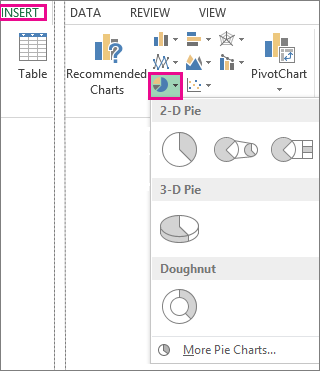
 .
. .
. .
.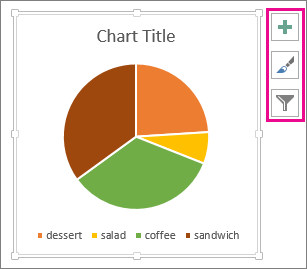


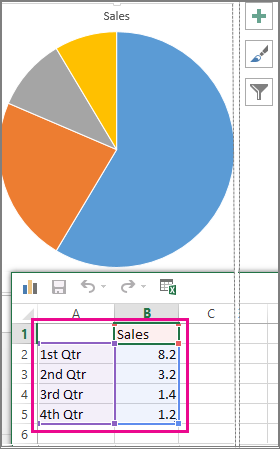

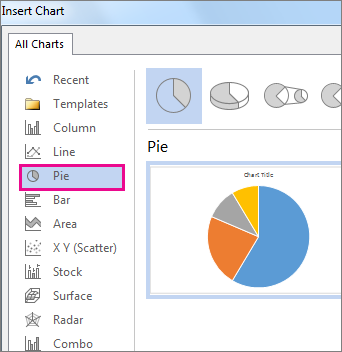

 .
.